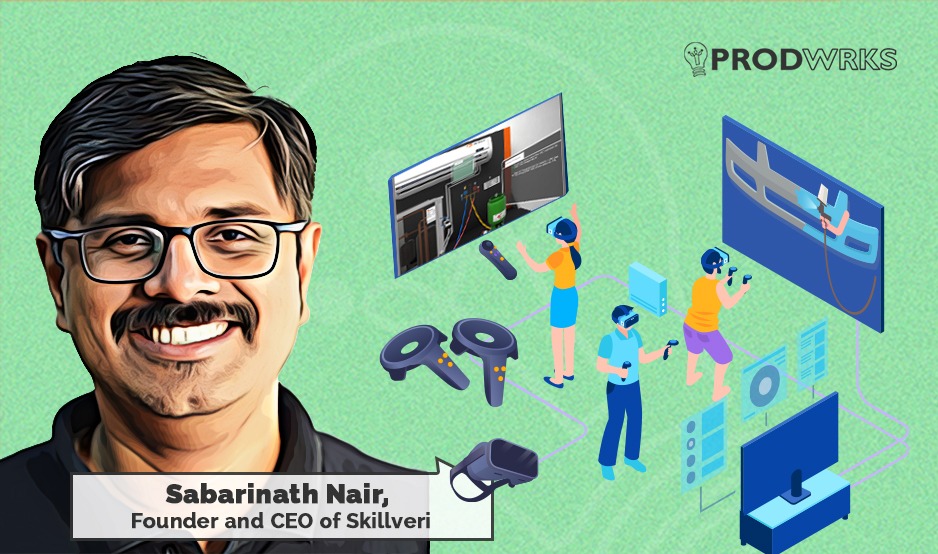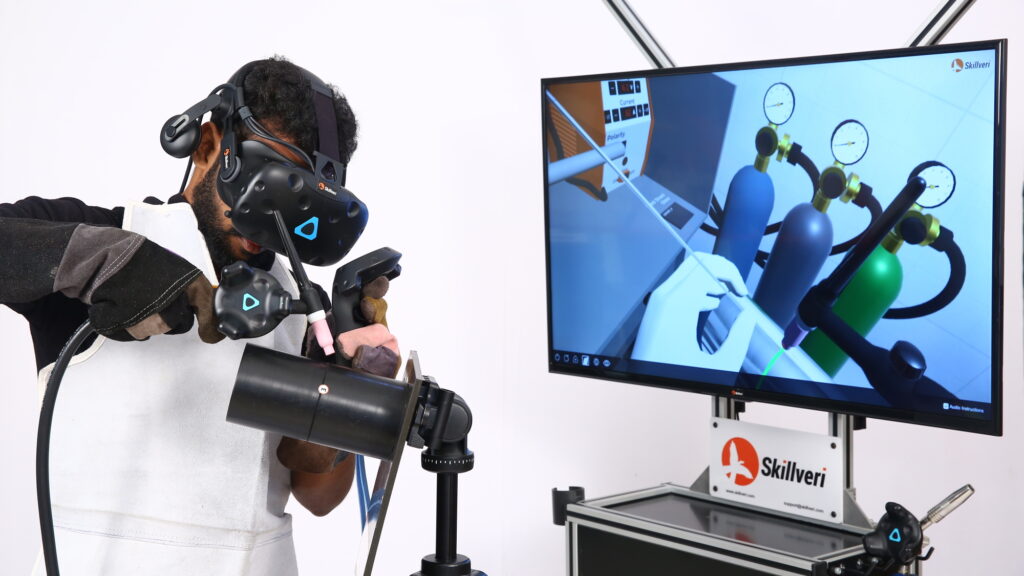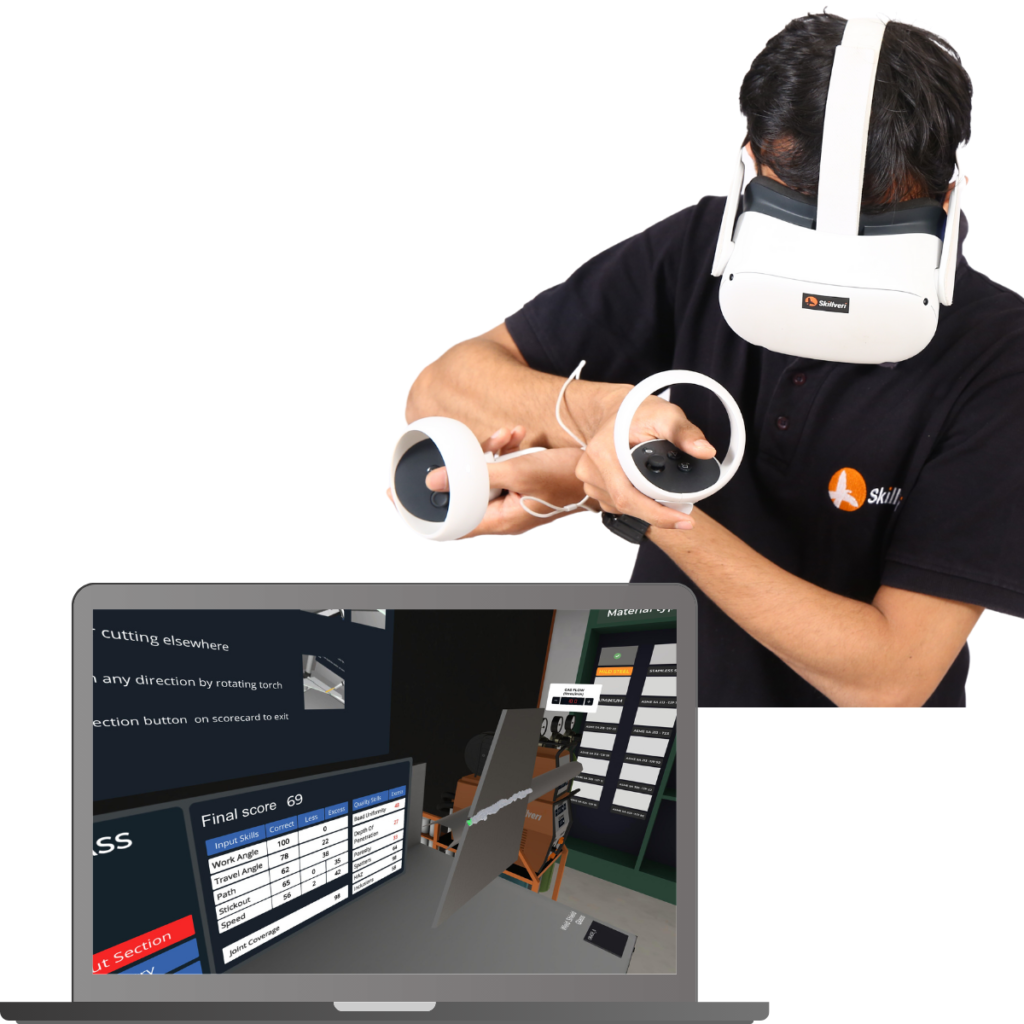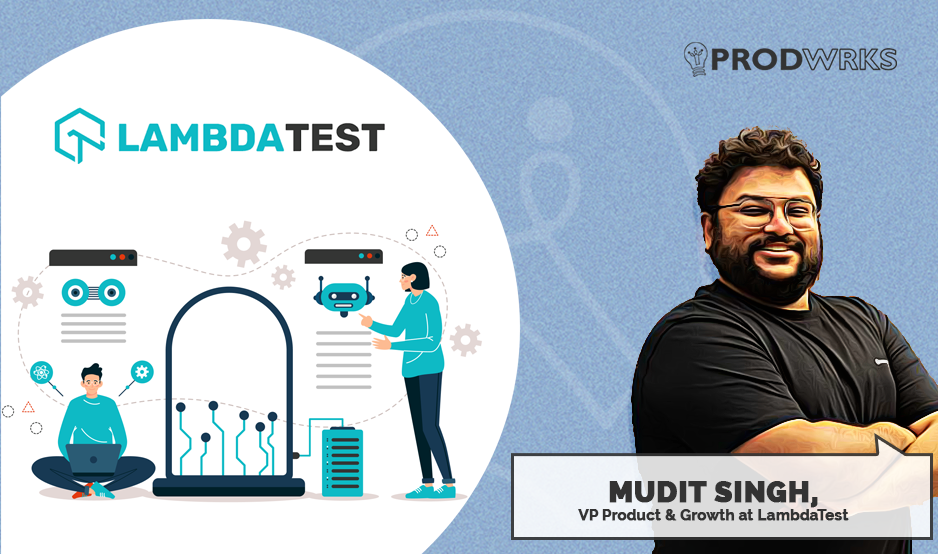
Fifteen years back, if people said that auto-rickshaw drivers would one day be using smartphones and Google Maps for navigation, would you have believed?
“The assumptions we make about how people use technology based on their economic status is wrong,” states Sabarinath Nair, the founder and CEO of Skillveri – India’s first simulation-based training platform for skilling blue-collar workforce.
Founded in 2012, Skillveri utilizes extended reality (XR) technologies like virtual reality (VR), augmented reality (AR), and mixed reality (MR) to give simulated skill training to industrial workers who aren’t usually considered as primary users of the metaverse or spatial computing.

Skillveri has over 150 clients today, including community colleges and trade schools in the US and large organizations in India like Cognizant, Ambuja Cements, Maruti Suzuki, TVS, etc. With XR technologies, Skillveri simulates real equipments in a workshop environment, enabling its clients to provide hands-on virtual training in vocational skills such as welding, painting, and installing and maintaining air conditioners and solar panels.
Can Simulated Training Solve Skills Gap in India?
Skillveri solves one of modern India’s biggest problems – the skill gap in the industrial workforce. India, a country of 1.4 billion people, imports skilled and semi-skilled workers from China and Peru to build its monuments and infrastructure projects to this day.
The Indian government also recognized the glaring skills gap in the industrial sector. In 2009, the Ministry of Skill Development and Entrepreneurship framed a policy to train 500 million people in new skills by 2022. However, the goal was abandoned as it was impossible to achieve with the available training infrastructure.
Sabarinath’s Skillveri addresses this market gap and the unmet need for a scalable solution to skill India’s workforce.
Sabarinath says, "India's skill-building capacity today with brick-and-mortar training centers is about 40 lakhs. It's an order of magnitude. You can't simply build 10 times the training center. So you have to scale with innovation."
He identified that simulated training using XR technologies offered the best way to impart practical knowledge to a large number of people in a short time in vocational skills like welding and painting that require dexterity and hours of practice.
Since 2012, Skillveri’s XR simulators have enabled 2 million people to improve their skills and deliver better quality work through 400 installations worldwide.
The Slow Pace of XR Adoption
"I think 95% of every new technology adopted is due to the initial hype. Only 5% of use cases will be real. People will be happy to pay for these 5% use cases. So, finding and building that 5% is the product leader's task. If people are continuously forced to pay for fancy things or perceived benefits rather than real use cases, there will be significant drop-offs."

"In the hype cycle, everybody said everything is Metaverse, and it will change the way we live. But it was not the case. Even today, if I want to order a burger, I'll open the Swiggy app on my phone and not wear a VR headset to do it. The smartphone is a useful technology because we use it for multiple things. But there isn't even one strong use case for XR devices that will make users wear them daily. That's one challenge for all product leaders in XR space."
"Extended reality solutions allow you to interact with the computing world in the same way you would in the real world. That's a huge opportunity. But if you look at the Apple Vision Pro or Meta's Quest videos, many things they build in virtual reality still have 2D interfaces. We have to make it as natural as possible."
Why does Skillveri succeed while other XR platforms fail?
Globally, there have been other simulated training solutions, but Skillveri’s success is due to it’s focus on practical use cases beyond the hype. They have cleverly implemented psychophysics and advanced XR models to mimic the workshop environment in a similar way the trainers and trainees would interact with it in the real world.
Sabarinath says, "The airline industry has been using simulators to train pilots for many years with great success. Why don't you see that with welding? We discovered that earlier simulators only tried to replicate a welding machine without accounting for the user. So, they failed. We made our solution to be a trainer's aide rather than just a welding machine equivalent."
For instance, the platform mimics one of the ways a trainer evaluates a welding class in real training centers just by listening to the welding sounds of a trainee doing a weld which changes depending on the proximity of the welding gun to the surface.
"Our physics engine is very strong and makes us stand apart from other solutions. We have added subtle nuances like the change in sound. Just by listening to the sound, the trainer can tell who is doing it right and who is doing it wrong while assessing multiple students. He gets this learning from years of experience on the shop floor, which we have tried to replicate with technology."
"By the time a trainee transitions from virtual to hands-on training, they'll know most of the variables and understand the basics of tools. They can do a decent job from the first try and get good at it quickly since simulated training modules give targeted feedback on what's right and wrong," says Sabarinathan.
Key Turning Point: Reducing Hardware Dependency and Pivoting to SaaS
Earlier, Skillveri built and assembled customized simulation hardware with realistic welding guns integrated with sensors to track various parameters. Sabarinath reveals that a key moment in their journey is the pivot to a software-centric business model.
The pivot came in 2020 when the COVID-19 pandemic disrupted their hardware + software business models and necessitated a reduced dependency on custom hardware.
Sabarinath noted, "When the pandemic hit, the Indian revenues had dropped to almost zero. But our customers in North America said, I know you can't ship hardware out from India. But can you port the software solution to work on any standard VR headset?"
So Skillveri modified their solution to work on off-the-shelf mixed reality devices like Meta’s Quest series. This pivot turned Skillveri from an Indian hardware + software product company into a successful SaaS company in the US.

With the introduction of the latest Quest 3, Skillveri offers mixed-reality training modules that blend the real world with the virtual world. He believes the affordable Quest3 at $500, with its easy-to-use interface, will be a major turning point for all simulated training solutions as they will reduce the resistance to adoption.
"With mixed reality headsets, a user can walk around and do normal things because it shows the real world too in a non-distorted 1:1 scale along with the simulated environment. So it makes training solutions easier to adopt and adapt to as the people buying the product are no longer blinded with just the virtual space and feel comfortable seeing the real world around them."
Vanity Mindset of the Indian Consumer
"Indian buyers want something physical to hold on to. Especially when investing several lakhs into a product, they want to tell the world they have a cool piece of technology to train their workforce. Not just that, they want a single vendor they can approach for software and hardware issues if something goes wrong."
"We still have some proprietary hardware bits in the XR devices we ship, but that portion is very small today. It used to be 100%, now it is 15-20%, and we hope to reduce it to 5%."
"Sometimes we buy stuff for vanity reasons, especially in India. We have had cases where the buyer would want to buy our solution only if it had a feature or a module that taught the highest skill levels of welding. But they wouldn't even require that as the student's learning needs from a simulator are still at the basic level."
He advises product leaders to differentiate between genuine requirements from users and mere vanity, to build features that matter and ship the products quickly to the market. This is a decision that sometimes needs to come from gut feeling.
Sabarinath says, "Building a skateboard first that can roll is better than building half a car that gets you nowhere."



